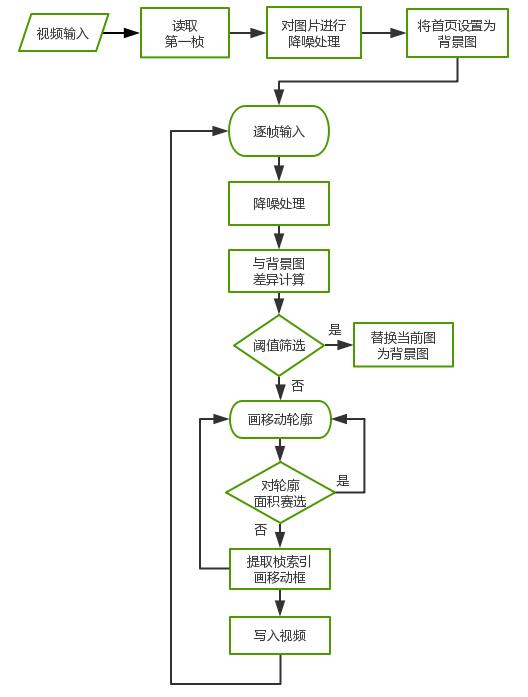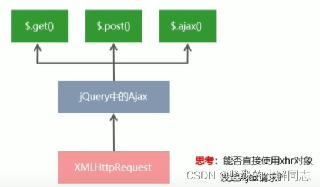python+opencv實現(xiàn)移動偵測(幀差法)
本文實例為大家分享了python+opencv實現(xiàn)移動偵測的具體代碼,供大家參考,具體內(nèi)容如下
1.幀差法原理
移動偵測即是根據(jù)視頻每幀或者幾幀之間像素的差異,對差異值設(shè)置閾值,篩選大于閾值的像素點,做掩模圖即可選出視頻中存在變化的楨。幀差法較為簡單的視頻中物體移動偵測,幀差法分為:單幀差、兩楨差、和三楨差。隨著幀數(shù)的增加是防止檢測結(jié)果的重影。
2.算法思路
文章以截取視頻為例進行單幀差法移動偵測

3.python實現(xiàn)代碼
def threh(video,save_video,thres1,area_threh): cam = cv2.VideoCapture(video)#打開一個視頻 input_fps = cam.get(cv2.CAP_PROP_FPS) ret_val, input_image = cam.read() index=[] images=[] images.append(input_image) video_length = int(cam.get(cv2.CAP_PROP_FRAME_COUNT)) input_image=cv2.resize(input_image,(512,512)) ending_frame = video_length fourcc = cv2.VideoWriter_fourcc(*’XVID’) out = cv2.VideoWriter(save_video,fourcc, input_fps, (512, 512)) gray_lwpCV = cv2.cvtColor(input_image, cv2.COLOR_BGR2GRAY) gray_lwpCV = cv2.GaussianBlur(gray_lwpCV, (21, 21), 0) background=gray_lwpCV# es = cv2.getStructuringElement(cv2.MORPH_ELLIPSE, (9, 4)) i = 0 # default is 0 outt=[] while(cam.isOpened()) and ret_val == True and i <2999: ## if i % 2==1: ret_val, input_image = cam.read() input_image=cv2.resize(input_image,(512,512)) gray_lwpCV = cv2.cvtColor(input_image, cv2.COLOR_BGR2GRAY) gray_lwpCV = cv2.GaussianBlur(gray_lwpCV, (21, 21), 0) diff = cv2.absdiff(background, gray_lwpCV) outt.append(diff) #跟著圖像變換背景 tem_diff=diff.flatten() tem_ds=pd.Series(tem_diff) tem_per=1-len(tem_ds[tem_ds==0])/len(tem_ds) if (tem_per <0.2 )| (tem_per>0.75): background=gray_lwpCV else: diff = cv2.threshold(diff, thres1, 255, cv2.THRESH_BINARY)[1] ret,thresh = cv2.threshold(diff.copy(),150,255,0) contours, hierarchy = cv2.findContours(thresh,cv2.RETR_EXTERNAL,cv2.CHAIN_APPROX_SIMPLE) # contours, hierarchy = cv2.findContours(diff.copy(), cv2.RETR_EXTERNAL, cv2.CHAIN_APPROX_SIMPLE) for c in contours: if (cv2.contourArea(c) < area_threh) | (cv2.contourArea(c) >int(512*512*0.3) ) : # 對于矩形區(qū)域,只顯示大于給定閾值的輪廓(去除微小的變化等噪點) continue (x, y, w, h) = cv2.boundingRect(c) # 該函數(shù)計算矩形的邊界框 cv2.rectangle(input_image, (x, y), (x+w, y+h), (0, 255, 0), 2) index.append(i) # cv2.imshow(’contours’, input_image) # cv2.imshow(’dis’, diff) out.write(input_image) images.append(input_image) i = i+1 out.release() cam.release() return outt,index,images```##調(diào)取函數(shù)outt=threh(’new_video.mp4’,’test6.mp4’,25,3000)
以上就是本文的全部內(nèi)容,希望對大家的學習有所幫助,也希望大家多多支持好吧啦網(wǎng)。
相關(guān)文章:

 網(wǎng)公網(wǎng)安備
網(wǎng)公網(wǎng)安備